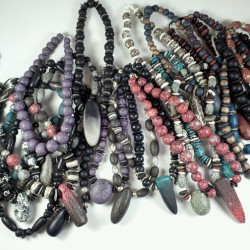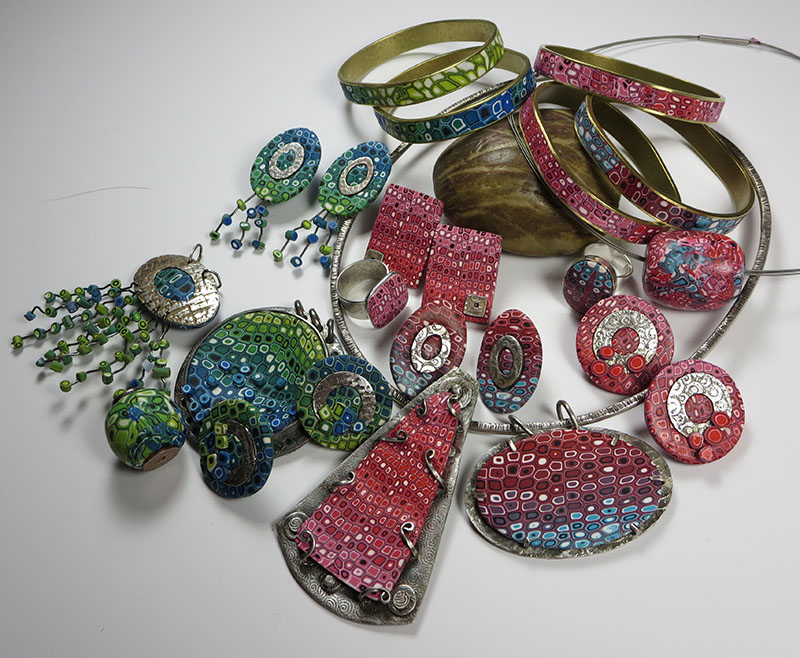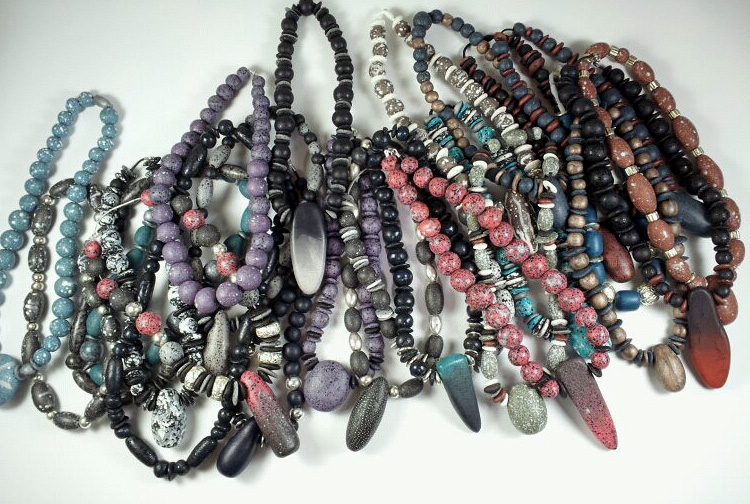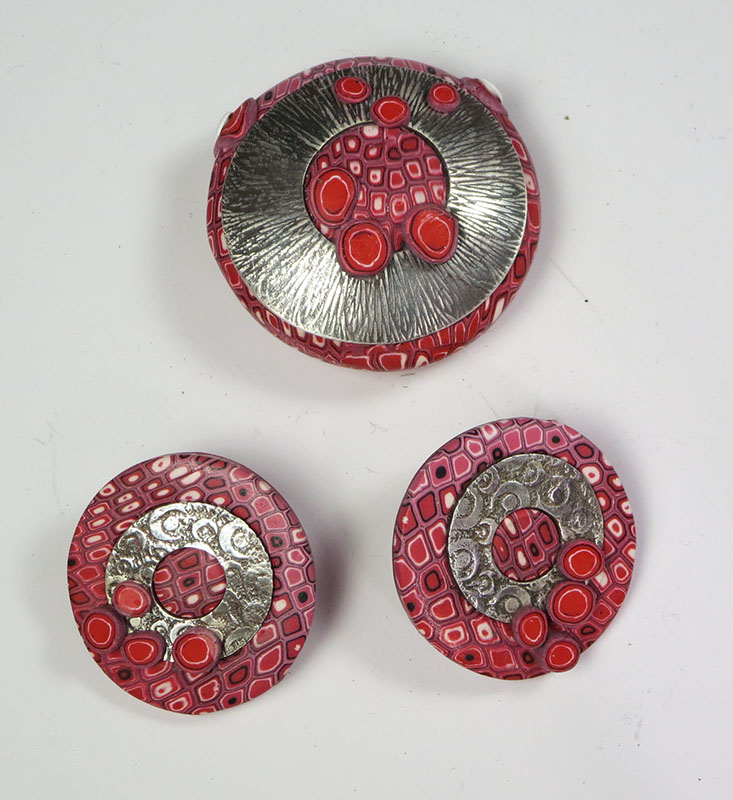Beads and Bangles: The Art of Polymer
Date: January 22, 2015 – February 12, 2015
Time: Every Thursday at 6:00 PM – 9:00 PM
Location: Metalwerx
http://www.metalwerx.com/workshop/674
Add color and texture to jewelry with polymer clay. Polymer clays were first formulated as a potential replacement for Bakelite, a popular plastic that was discontinued because it was flammable. Nowadays, polymer is a safe alternative that does not shrink when cured and can be finished in a toaster oven. It can be sculpted, carved, stamped, textured, sanded, buffed, and even painted. This course covers the fundamentals of working with this distinctive material.
Start out with an overview of types of clay and tools available, proper ways to prepare, cure, store and reuse polymer. Learn how to mix colors for custom blends and achieve interesting effects with translucent and opaque color mixing. Move on to create and combine simple canes to make surface textures on beads, bangles and even buttons in an array of shapes and colors. Forming methods for different shapes and sizes of beads (round, lentil, cone, bicone, donut, etc.) will also be included.
More info on Polymer: Check out an incredible exhibition, Terra Nova: Polymer Art at the Crossroads, at the Racine Art Museum, featuring over 200 objects made of polymer, including adornment, vessels, and furniture. American Craft magazine also published an article on polymer in late 2011, How Polymer Hit the Big Time Of course, if you’d like to see more of Pamela’s work, please visit her website pamelacole.com
This class is 4 sessions long. Each class meets for 3 hours.
Materials & Tools
Additives, tools and templates/forms are available for use at class. Students will need six 2.0 oz packages of Premo clay in several complementary colors (~$15 dollars).
Students Can Bring:
- A selection of polymer clay will be available for purchase at the class, but students are welcome to bring their own if they prefer. We suggest at least six 2.0 oz packages of Premo clay in several complementary colors, including one metallic color.
- Tools are provided for use at class, but students who already have the following can bring them if they wish: clay blades—one rigid, one flexible and a clay roller, assorted shape cutters, pasta machine, metal ruler
- Resources for polymer include local art supply stores as well as
Working with Polymer and Metal Clay
February 22-23, 2014 Metalwerx Waltham, MA
Study the fundamentals of both working in silver clay and in polymer clay. The workshop will start by looking at and discussing examples of the different ways of combining these two clays. Students will be guided through creating a variety of simple designs for pendants, earrings, and/or brooches that can be completed during the workshop.
Silver clay components will be crafted on the first day, fired and finished in preparation for combining them with polymer clay on the second day. When working with silver clay, students will learn how to texture, shape and form and finish simple objects, such as charms, frames, and bails. (Advanced students may create more elaborate structures if they chose.) Day two will cover preparing and conditioning polymer clay, mixing colors, simple canes, extruded canes, shaping and forming the clay, attaching the clay and silver, and finishing techniques.
In addition to sharing her passion for exploring the creative possibilities of these two clays, Pamela will make available a large selection of texturing and shaping tools in the workshop for students to use in creating their designs. Pamela’s mission as a teacher is to promote a sense of playful wonder and exploration where every student leaves feeling competent and creative in their own expression. If you’d like to see more of Pamela’s work, please visit her website pamelacole.com/
No prior experience is needed. Students with experience will be able to integrate previously created metal clay pieces and proceed at their own pace.
http://www.metalwerx.com/workshop/645
Read the Metalwerx blog posting about this class
Beads and Bangles: The Art of Polymer
Date: April 17, 2014 – May 08, 2014
Time: Every Thursday at 10:00 AM – 1:00 PM
Location: Metalwerx Waltham, MA
Add color and texture to jewelry with polymer clay. Polymer clays were first formulated as a potential replacement for Bakelite, a popular plastic that was discontinued because it was flammable. Nowadays, polymer is a safe alternative that does not shrink when cured and can be fired in a home oven. It can be sculpted, carved, stamped, textured, sanded, buffed, and even painted. This course covers the fundamentals of working with this distinctive material.
Start out with an overview of types of clay and tools available, proper ways to prepare, cure, store and reuse polymer. Learn how to mix colors for custom blends and achieve interesting effects with translucent and opaque color mixing. Move on to create and combine simple canes to make surface textures on beads, bangles and even buttons in any array of shapes and colors. Forming methods for different shapes and sizes of beads (round, lentil, cone, bicone, donut, etc.) will also be included.
More info on Polymer: Check out an incredible exhibition at the Racine Art Museum featuring over 200 objects made of polymer, including adornment, vessels, and furniture, Terra Nova: Polymer Art at the Crossroads. American Craft magazine also published an article on polymer in late 2011, How Polymer hit the big time, Of course, if you’d like to see more of Pamela’s work, please visit her website pamelacole.com
This class is 4 sessions long. Each class meets for 3 hours. If a make-up session is necessary, it will be held on May 23.
Metalwerx Catalogue and Registration
Creating Colorful, Lightweight Forms in Polymer
Level: All Skill Levels
Requirements: None
Program: Summer
Status: Open
Length: 1 Days
Tuition: $ 130
Only $ 123.5 for registration before 04 July 2014
Materials: TBA
Date: August 04, 2014
Time: 10:00 AM – 5:00 PM
Location: Metalwerx
Add color and texture to jewelry! In one day, students will be taught how to create symmetrical and irregular hollow forms in polymer using natural, found and miscellaneous household objects. This course will also explore embellishing forms with surface techniques using canes, metallic foils, clay additives, and carving. Expect to leave with a finished piece or two.
No prior experience is necessary but students with experience can pursue more challenging projects with instructor guidance. Methods for building hollow forms can are also applicable for metal clay construction.
Materials & Tools
The instructor will provide additives, tools and templates/forms. Students will need six 2.0 oz packages of Premo clay in several complementary colors (~$15 dollars).
Students Can Bring:
•A selection of polymer clay will be available for purchase at the class, but students are welcome to bring their own if they prefer. We suggest at least six 2.0 oz packages of Premo clay in several complementary colors, including one metallic color.
•Tools are provided for use at class, but if students who already have the following can bring them if they wish: clay blades—one rigid, one flexible and a clay roller.



